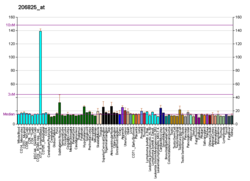OXTR
Oksitocinski receptor, znan i kao OXTR, jest protein koji je kod ljudi kodiran genom OXTR sa hromosoma 3. Funkcionira kao receptor za hormone i neurotransmiter oksitocin.[4][5][6][7][8]

Aminokiselinska sekvenca
urediDužina polipeptidnog lanca je 389 aminokiselina, а molekulska težina 42.772 Da.[10]
| 10 | 20 | 30 | 40 | 50 | ||||
|---|---|---|---|---|---|---|---|---|
| MEGALAANWS | AEAANASAAP | PGAEGNRTAG | PPRRNEALAR | VEVAVLCLIL | ||||
| LLALSGNACV | LLALRTTRQK | HSRLFFFMKH | LSIADLVVAV | FQVLPQLLWD | ||||
| ITFRFYGPDL | LCRLVKYLQV | VGMFASTYLL | LLMSLDRCLA | ICQPLRSLRR | ||||
| RTDRLAVLAT | WLGCLVASAP | QVHIFSLREV | ADGVFDCWAV | FIQPWGPKAY | ||||
| ITWITLAVYI | VPVIVLAACY | GLISFKIWQN | LRLKTAAAAA | AEAPEGAAAG | ||||
| DGGRVALARV | SSVKLISKAK | IRTVKMTFII | VLAFIVCWTP | FFFVQMWSVW | ||||
| DANAPKEASA | FIIVMLLASL | NSCCNPWIYM | LFTGHLFHEL | VQRFLCCSAS | ||||
| YLKGRRLGET | SASKKSNSSS | FVLSHRSSSQ | RSCSQPSTA |
Funkcija i lokacija
urediOXTR protein pripada porodici G-protein spregnutih receptora, konkretno Gq,[4] i djeluje kao receptor za oksitocin. Njegovu aktivnost posreduje G-protein koji aktivira nekoliko različitih sistema drugog glasnika.[11][12]
Oksitocinski receptori se eksprimiraju u mioepitelnim ćelijama mliječnim žlijezdama, i u miometriju i endometriju maternice na kraju trudnoća. Sistem receptora oksitocin-oksitocin ima važnu ulogu kao induktor kontrakcija maternice tokom porođaja i izbacivanja mlijeka.
OXTR je također povezan sa centralnim nervnim sistemom. Vjeruje se da gen ima glavnu ulogu u društvenom, kognitivnom i emocijskom ponašanju.[13] Vjeruje se da je povećanje ekspresije ovog gena povezano s neemocijskim osobinama, grubim razmišljanjem i problemima s prepoznavanjem lica i emocija. Također se vjeruje i da smanjenje ekspresije ovog gena dovodi do prenatalnog stresa, postnatalne depresije i socijalne anksioznosti.[13] Moraju se obaviti dalja istraživanja prije zaključivanja ovih nalaza,ali jaki dokazi upućuju u tom smjeru . OXTR je također u snažnoj korelaciji s amigdalom i odgovorima povezanim sa strahom. Studije sugeriraju da metilacija OXTR-a, koja smanjuje regulaciju oksitocinskih mehanizama, rezultira povećanjem sive tvari u amigdali, što se dalje povezuje sa smanjenjem parasimpatičkog tonusa.[14]
Kod nekih sisara, oksitocinski receptori se također nalaze u bubrezima i srcu.
Reference
uredi- ^ a b c GRCm38: Ensembl release 89: ENSMUSG00000049112 - Ensembl, maj 2017
- ^ "Human PubMed Reference:". National Center for Biotechnology Information, U.S. National Library of Medicine.
- ^ "Mouse PubMed Reference:". National Center for Biotechnology Information, U.S. National Library of Medicine.
- ^ a b Gimpl G, Fahrenholz F (april 2001). "The oxytocin receptor system: structure, function, and regulation". Physiological Reviews. 81 (2): 629–83. doi:10.1152/physrev.2001.81.2.629. PMID 11274341. S2CID 13265083.
- ^ Zingg HH, Laporte SA (juli 2003). "The oxytocin receptor". Trends in Endocrinology and Metabolism. 14 (5): 222–7. doi:10.1016/S1043-2760(03)00080-8. PMID 12826328. S2CID 21540056.
- ^ EntrezGene 5021
- ^ Kimura T, Tanizawa O, Mori K, Brownstein MJ, Okayama H (april 1992). "Structure and expression of a human oxytocin receptor" (PDF). Nature. 356 (6369): 526–9. Bibcode:1992Natur.356..526K. doi:10.1038/356526a0. PMID 1313946. S2CID 4273722. Arhivirano s originala (PDF), 21. 9. 2017. Pristupljeno 4. 11. 2021.
- ^ Simmons CF, Clancy TE, Quan R, Knoll JH (april 1995). "The oxytocin receptor gene (OXTR) localizes to human chromosome 3p25 by fluorescence in situ hybridization and PCR analysis of somatic cell hybrids". Genomics. 26 (3): 623–5. doi:10.1016/0888-7543(95)80188-R. PMID 7607693.
- ^ Koehbach J, Stockner T, Bergmayr C, Muttenthaler M, Gruber CW (februar 2013). "Insights into the molecular evolution of oxytocin receptor ligand binding". Biochemical Society Transactions. 41 (1): 197–204. doi:10.1042/BST20120256. PMC 3634130. PMID 23356283.
- ^ "UniProt, P30559" (jezik: engleski). Pristupljeno 4. 11. 2021.
- ^ Devost D, Wrzal P, Zingg HH (2008). "Oxytocin receptor signalling". Advances in Vasopressin and Oxytocin — from Genes to Behaviour to Disease. Progress in Brain Research. 170. str. 167–76. doi:10.1016/S0079-6123(08)00415-9. ISBN 978-0-444-53201-5. PMID 18655881.
- ^ Gimpl G, Reitz J, Brauer S, Trossen C (2008). "Oxytocin receptors: ligand binding, signalling and cholesterol dependence". Advances in Vasopressin and Oxytocin — from Genes to Behaviour to Disease. Progress in Brain Research. 170. str. 193–204. doi:10.1016/S0079-6123(08)00417-2. ISBN 978-0-444-53201-5. PMID 18655883.
- ^ a b Maud C, Ryan J, McIntosh JE, Olsson CA (maj 2018). "The role of oxytocin receptor gene (OXTR) DNA methylation (DNAm) in human social and emotional functioning: a systematic narrative review". BMC Psychiatry. 18 (1): 154. doi:10.1186/s12888-018-1740-9. PMC 5975530. PMID 29843655.
- ^ Lancaster K, Goldbeck L, Puglia MH, Morris JP, Connelly JJ (novembar 2018). "DNA methylation of OXTR is associated with parasympathetic nervous system activity and amygdala morphology". Social Cognitive and Affective Neuroscience. 13 (11): 1155–1162. doi:10.1093/scan/nsy086. PMC 6234329. PMID 30257007.
Vanjski linkovi
uredi- Oxytocin receptor na US National Library of Medicine Medical Subject Headings (MeSH)
- "Symbol Report: OXTR". HUGO Gene Nomenclature Committee.
- "Vasopressin and Oxytocin Receptors: OT". IUPHAR Database of Receptors and Ion Channels. International Union of Basic and Clinical Pharmacology. Arhivirano s originala, 3. 3. 2016. Pristupljeno 4. 11. 2021.
Ovaj članak uključuje tekst iz Nacionalne medicinske biblioteke Sjedinjenih Država, koji je u javnom vlasništvu.
Šablon:Neuropeptidni receptori Šablon:Modulatori oksitocinskih i vazopresinskih receptora


